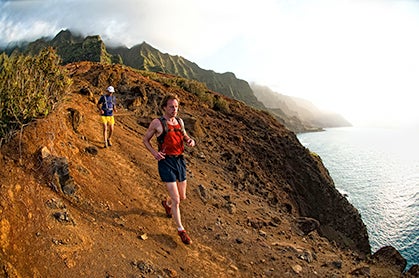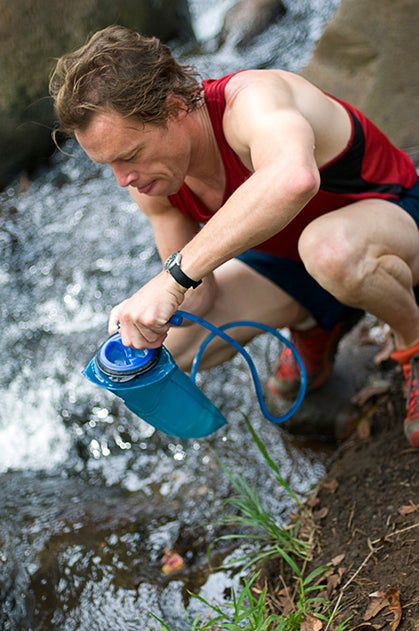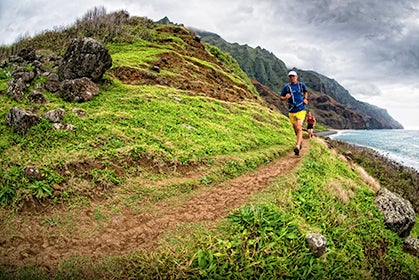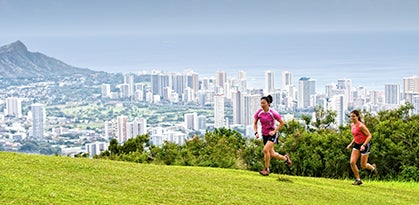New perk! Get after it with local recommendations just for you. Discover nearby events, routes out your door, and hidden gems when you sign up for the Local Running Drop.
Hitting the reset button

Justin Tade and Brendan McHugh running the Kalalau Trail along the Na Pali Coast of Kauai, Hawaii. Photo by Chris Hunter.
My horoscope for the week of March 23, 2009 read: “You hit the reset button in your life this week.” So the next week, I headed to Hawaii to run trails. Sixteen months ago, though, I didn’t know if I would ever run another trail, following a gunshot wound to my leg.
In a jet over the Pacific. Unsettled. Wondering. What’s in store over the course of the next nine days? How will my leg hold up? I’m an open book full of blank pages where unpleasant memories can’t be reached—thanks to dreams of trails bathed in sunlight and shrouded in rainforest canopy.
While most of Hawaii is a paradise, each island is unique in its flora, fauna and vibe. Chris Hunter, 28, a longtime resident of North Shore Oahu, and I had concocted our Hawaiian itinerary over beers after running across the Grand Canyon (Chris took photos). After heatedly discussing Hawaii’s greatest trails, we narrowed it down to two “big ones.” We chose the Na Pali Coast, 22 miles (roundtrip) of narrow, red-dirt trail on the northwest coast of Kauai, and Maui’s Haleakala Crater, the centerpiece of Haleakala National Park, which stretches from the Crater to the pools of Oheo Gulch on the south coast at Hana. And, on a lark (based on an insider tip), we decided to hit the easily accessible rainforest trails just outside of the bustle of Honolulu.

Tade fills up in one the numerous clear streams en route. Photo by Chris Hunter.
Na Pali Coast, Kauai
Na Pali means “the cliffs,” and here on the northwest coast of Kauai they raise like knifeblades out of crystal-blue waters. On this 11-mile stretch of roadless coast, five major valleys, Kalalau, Honopu, Awaawapuhi, Nualolo and Milolii stretch like fingers into the sea. The mouths of the valley’s creeks, like at Hanakapiai and Hanakoa, once home to ancient Hawaiians, are now campsites and rest areas. At the trailhead next to Kee Beach, Hunter, now living in Moab, Utah, Brendan McHugh, who calls home base Boulder, Colorado, and I don our ultralight packs and prepare to climb a rock-strewn trail.
Brendan and Chris are both professional skydivers and all-around adventurers who have worked the same skydiving drop zones over the years. So when not talking about trail running, they were talking about the colorful characters who work at drop zones (present parties included) or looking at the cliffs above wondering if there was a way they could BASE jump them.
Although a comfortable two- to three-feet wide, the trail features slick tree roots, random rocks and mud puddles. Flowers, guava and kukui tree and other jungle flora keep most of this section of “The Garden Island” in cool shade. Soon, though, the trail is more suited to goats, literally. A noise off trail sounds like a small boy calling for his dad—a kid (goat) bleats from a promontory that falls hundreds of feet into the sea. The nimble mammals were introduced by the first sailing ships that landed on the islands and have since turned feral. The trail is now a mere foot wide and more exposed to the tropical sun.
The path rises and falls easily, with a total elevation gain and loss of 2200 feet over 11 miles. We bomb down sections that weave into the rainforests and mindfully jog or hike the treacherous ones. The cliffs are covered in rainforest so green they make your eyes water, and blue-gray clouds dance and tremble between them. Far below, white lines of surf march toward the beach, every wave a subtle change that will never happen again. Birds sing their native songs, their melodies combining with the rhythm of heartbeat and breath. We soak up Na Pali’s feast: the pali above, the surf below, the guava fruit overhead, the elephant-ear plants (yes, they are the size and shape of elephant ears) in the gulley below, onyx kukui nuts resembling large marbles paving the red-dirt trail, champagne sunlight filtering through the jungle canopy.
“How’s your leg?” Brendan asks as we started an easy descent into another valley. Short and wiry, built like a natural runner, Brendan is still on his toes and looks like he could run to the trail’s end and back by sunset.
“Good, thanks,” I say, secretly hoping we are close to our campsite as the late-afternoon sun raced to drop into the sea. I am elated, though, that my leg feels fully trail worthy.
Soon, we hit our campsite in the Hanakoa Valley, with a pit toilet, a shelter and several campsites. We drop our packs, and let the chilly stream water soothe our feet. We drop iodine tablets in our water and lay our bedding on stone-walled terraces built long ago for a coffee plantation. The next morning we toss on hydration packs and blast toward Kalalau Beach. En route, we meet Mauricio Puerto, a member of HURT (Hawaii Ultra Running Team), on his return leg. Mauricio, powerfully built and running with the steady stride of an experienced trail runner, took a breather, though he looked like he was hardly breathing.
“How long did it take to get to the beach?” I asked.
“Three-and-a half-hours from the trailhead,” he replied, “I had better get going—I promised my wife I would be back in time to take her to dinner.” He blasted off.
Two hours later, we hit the end of the trail at Kalalau Beach, and for the first time on this trek feel sand between our toes. We stash our gear and body surf. The waves are so strong in the winter that ocean kayaks rarely land here, but in the summer kayaks line the beach and the place becomes Party Central.
Before returning to another night at camp we rinse off in a waterfall pouring onto the beach. We could have run the entire coast in a day, but running it in pieces and camping put us closer to this land, absorbing it while being absorbed.
Our run back to the trailhead at Kee Beach is fast—even with packs—as we look forward to a lunch that is neither gel nor comes from a package. Shirtless and barefoot, we hop in the car and blast down Highway 560, the only road between the Na Pali Coast and Lihue, and stop in the village of Hanalei. We buy a six-pack of Longboard Lager and order loco moco and plate lunches—both calorie-laden gut busters. Loco moco is a fried egg and a beef patty stacked on rice and smothered in brown gravy. Plate lunches, favored by the locals, are comprised of white rice, macaroni salad and fish or meat, usually fried.

Smooth cruisin’ above the Pacific. Photo by Chris Hunter.
Haleakala, Maui
We take a day to rest and re-supply on Maui. Awakening at 4 a.m., we drive fast to the Haleakala’s rim to catch sunrise. At seven miles across, two miles wide and 2500 feet deep, Haleakala is the world’s largest dormant volcano. It is also at 10,023 feet and, with the wind howling, feels arctic compared to Kauai’s rainforests.
Upon seeing sunrise from Haleakala’s rim, Mark Twain wrote: “… the sublimest spectacle I ever witnessed, and I think the memory of it will remain with me always.” A palette of pastels rides on galloping clouds, and the sunrise over Haleakala is, indeed, gloriously humbling.
We plan to run a route through the crater, so Chris volunteered to drive our rental car six miles back down the road to the Halemau’u trailhead and hitchhike back. We hit the trail hoping for warmer temperatures below. Starting from the visitor’s center at the crater’s rim, the Sliding Sands trail leads to the crater floor where it branches onto a network of side trails. Sliding Sands is a bomber—a refreshing change from the mincing footwork required on the Na Pali Coast—wide enough to run shoulder to shoulder, the cinders underfoot are forgiving and the crater walls, for awhile at least, provide a welcome respite from the howling winds at the rim.
“Good, God, it’s cold,” I grumble, hoping my ankles and knees loosen up soon.
Within Haleakala Crater, numerous small eruptions have built small cinder cones, and you sense that the most recent eruption 200 years ago will not be the last. Though we have lost a little over 2000 feet of elevation it is still cold on the crater floor. We turn onto the first of four side trails that head north toward Halemau’u Trail. Clouds move in and out and the wind whips, as we cross a moonscape of cinders and monolithic, brooding hoodoo lava formations.
We run a loop trail that leads to the “Bottomless Pit.” The rocks here are splattered in shades of red, rust, sulfur-yellow and moss-green. From there, we swing northwest on Halemau’u Trail toward the rim, taking a short detour onto Silversword Loop. Silversword, which looks like a yucca made of aluminum and is found nowhere else in the world, was nearly wiped out in the early 20th century by feral goats, and its amazing sci-fi appearance add to the crater’s wonder.
About a mile after leaving the Silversword Loop, we rest at the Holua campground, where there is a primitive rental cabin with 12 bunks and a wood-burning stove. In fact, the Park Service maintains three primitive cabins in the crater, at Holue, Kapalaoa and Paliku, available for rental.
After our rest, we beeline for the rental car at the Halemau’u Trailhead. Focusing on the views across the crater, I am suddenly sent sprawling. The lava rock is sharp like shattered glass and falling results in a blood and skin donation. My bleeding hands, legs and arms remind me that in ancient times this crater was a power center for Hawaiian kahunas who made sacrifices to their gods.

Escaping the bustle of Honolulu, Julie Ng and Cindy Gibson are on their way to savor an afternoon in the lush Honolulu Forest Reserve. Photo by Chris Hunter.
Honolulu, Oahu
On Oahu we take a rest day on the North Shore, then Chris and I part ways with Brendan. The North Shore of Oahu is surfing’s Mecca. Watching surfers challenge 20-foot waves is exhilarating, and there are miles of beach to run. But, acting on a tip about some cool trails close to Honolulu from Honolulu-based trail runners Julie Ng and Cindy Gibson, we pack up and head to the city. Julie, a 41-year-old software-applications engineer, and Cindy, 27, a reporter for the Pacific Business News, have both run the Honolulu and Volcano marathons numerous times. The Volcano Marathon, held on the Big Island, is a trail marathon over lava flows and through rainforests.
Just minutes from the concrete jungle of Honolulu, we meet up with Julie and Cindy at parking area #2 of the Honolulu Mauka Trail System. This 14-mile system snakes through the Honolulu Watershed Preserve, which overlooks Honolulu, and is the venue for the renowned HURT 100. Limited to 100 entrants, the HURT 100, which includes 100-mile and 100-kilometer events over a 20-mile loop, is held in January and is 99-percent singletrack on rainforest trails. The total elevation gain for the 100-miler is 24,935 feet.
“How often do you get out here?” I ask, as we take off through the trees.
“We’re out here all the time,” Julie replies.
“These trails are so easy to get to from downtown,” Cindy chimes in, “and offer such great variety, with bamboo forests, great city views and guava and ginger along the trail in the summer.”
The trails weave in and out of the valleys and are moderately hilly. So if you’re ever stuck in a Waikiki hotel and need a mud fix, the bird song and skittering of lizards offer a peaceful respite from the bustle of Honolulu.
Chris, Julie, Cindy and I finish our day at an open-air bar in downtown Honolulu. Then, racing to the airport, I change out of my running clothes in the back of Chris’s minivan, and he pours me onto the plane for an overnight flight to San Francisco. Typically I would dread returning to the real-world rat race. But, I am grateful—this trip has made me realize is that no matter what life dishes out I know there is a trail I haven’t run (several in Hawaii as a matter of fact), but, more importantly, can run.
NA PALI COAST, HAWAII
Getting there
From the airport in Lihue, take Highway 56 to the end of the road. On the way, stock up in Hanalei, where there is a market, well-stocked backpacking shop and a natural-foods store.
Gear
Hydration system, water treatment (iodine or filter), sunscreen, mosquito repellent, first-aid kit, light rain gear.
Seasons
Winter (October through April) is wetter, while summer (May through September) is dryer. Temperatures range from upper-50s to mid-80s year round.
Hazards
Falling rocks, dangerous surf (primarily in winter), steep drop-offs, rough trail
and a citation if you don’t have a permit from the Hawaii State Parks Department
(www.hawaiistateparks.org/camping/permit_napali.cfm).
Information
The Ultimate Kauai Guidebook: Kauai Revealed, by Andrew Doughty; On the Na Pali Coast: A Guide for Hikers and Boaters, by Kathy Valier.
This article originally appeared in our May 2010 issue.